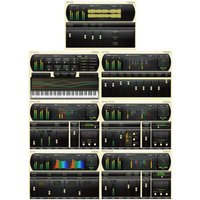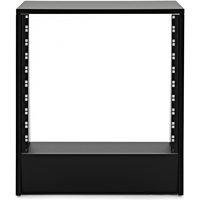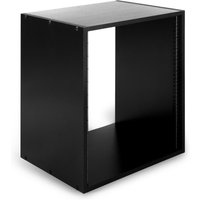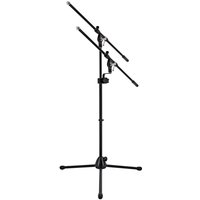
The Lexicon PCM Native Effects Plugin Bundle is a comprehensive collection of seven unique processors. This versatile bundle with native plug-ins brings seven unique effect plug-ins to your fingertips presenting factory presets with the finest collection available spanning decades of accomplished products.
The bundle has been designed to offer flexibility enabling you to craft and tailor audio applications to the highest level of sonic quality and function. This powerhouse bundle ensures these plug-ins take center stage in your DAW choices; it is compatible with major DAWs thanks to the VST AU AAX and RTAS formats.
The PCM Native Effects Bundle features Pitch Shift MultiVoice Pitch Chorus Resonant Chords Random Delay Dual Delay and Stringbox. All these effect plug-ins offer the highest level of sophistication providing an unparalleled experience in terms of sonic quality and function. Whether you require flexibility inspiration or professional-grade equipment for your audio application the PCM Native Effect Bundle is the ultimate plug-in package that will make sound effects design come to life.
Please Note: This product comes in the form of a digital download code that will be sent to your email for activation.
A world-class range of plug-ins The PCM Native Effects Bundle is a versatile plug-in solution that can run in mono stereo or mono in/stereo out. This bundle offers a wide array of adjustable parameters allowing you to tweak and save presets according to your preferences. With the addition of Input Output and Feedback Meters as well as Stereo/Phase metering youll have complete control over your sound.
One standout feature of the PCM Native Effects Bundle is the multidimensional real-time display located centre screen. There are three animated screens to choose from each displaying different visualizations of the algorithm in real time. These displays aid in shaping your sound and offer a unique and engaging user experience.
The PCM Native Effects Bundle is fully functional and cross-platform making it a flexible solution that can fit into your hardware/software platform of choice. Additionally you can load your custom presets into a different DAW providing even more flexibility when it comes to your creative process.
Pitch Shift Pitch Shifting is a common technique used in sound design for movies and music production. It involves changing the pitch of a vocal or instrument to create a desired effect. For instance it can be used to correct pitch when converting between various frame rates or to create unique effects like the “Demonic” or “Chipmunk” voice.
The Pitch Shift algorithm allows you to adjust the pitch using one of two types: Musical or Percent mode. In Musical mode you can adjust the pitch in semitones (-12 to 12) and/or cents (-50 to 50). In Percent mode you can adjust the pitch between -60% and 60%. The algorithm also provides control over crossfade low shift cutoff frequency smart shift and correlation.
With Pitch Shift musicians can experiment with creating unique sounds that add character to their music such as making a guitar solo stand out or transforming a vocal into a haunting or hilarious effect. Sound engineers can also use Pitch Shift to correct pitch issues in post-production for films and videos.
MultiVoice Pitch The MultiVoice Pitch algorithm is a powerful pitch shifter that offers an array of features for sound designers and music producers. This algorithm is ideal for creating thick and lush vocal effects or far-out special effects that contain multiple delay lines.
With MultiVoice Pitch each voice has an independent control pitch shifter which can be adjusted in semitones (-12 to 12) and/or cents (-50 to 50). The algorithm also provides feedback control capabilities which are used for creating arpeggios. To further enhance the sound MultiVoice Pitch includes six total delay voices (three delay voices per input channel) each with an independently adjustable delay time of up to 4.75 seconds. Additionally each voice has independent output and feedback control.
The output and feedback paths for each delay voice include an independently selectable filter adjustable filter frequency filter bandwidth filter shelf polarity level and pan control. This algorithm offers complete control over the sound allowing sound designers and music producers to experiment with various effects and create unique soundscapes. MultiVoice Pitch can add depth and dimension to vocals instruments and other sounds giving your tracks a professional and polished sound.
Chorus The Chorus (Flange) algorithm is a versatile tool that sound designers and music producers use to create a range of effects on different instruments. It is commonly used to thicken a track add shimmering effects or create a sweeping sound similar to that of a phaser effect.
While this algorithm is similar to other delay algorithms in the PCM Effects Bundle the difference lies in its modulation aspect. The LFO modulators are available as in the Random Delay algorithm but the voices move differently in the Chorus (Flange) algorithm. The voices move gradually creating noticeable pitch effects that enhance the overall sound.
In chorus mode the voices move independently resulting in a thickening effect without significant filtering. In flange mode voices are typically paired at close intervals creating comb-filtering due to cancellation. The feedback paths are often fed back nearly to the point of instability resulting in unique and interesting effects.
The Chorus (Flange) algorithm has eight total delay voices (four delay voices per input channel) with each voice having an independently adjustable delay time of up to 9.5 seconds (plus an additional 1 second of “Wander” delay). The algorithm also includes selectable LFO and independent output and feedback control. Each of the delay voices output and feedback paths includes an independently selectable filter with adjustable filter frequency filter bandwidth filter shelf polarity level and pan control.
Resonant Chords The Resonant Chords algorithm originally featured in the Lexicon PCM70 is a powerful tool for creating unique sounds and effects. This algorithm enables you to tune multiple delay voices to resonate on specific notes producing glistening chords strange ringing delays or even bizarre room sounds.
When using the Resonant Chord algorithm impulsive energy is utilized at the inputs to excite six resonant voices or notes. While these voices can resonate with any input the most effective excitation typically includes all frequencies like percussion. The algorithm can also create a tonal ambience where certain notes rise ethereally from the background when used with various instruments.
The Resonant Chords algorithm has eight total delay voices (four delay voices per input channel). Each voice has independently adjustable delay time of up to 9.5 seconds resonance frequency resonance amount resonance filter resonance detune and independent output and feedback control. Additionally each of the delay voices output and feedback paths includes an independently selectable filter adjustable filter frequency filter bandwidth filter shelf polarity level and pan control.
With its array of features the Resonant Chords algorithm offers complete control over the sound allowing sound designers and music producers to create captivating and unique soundscapes. Whether youre looking to add glistening chords to your music or create bizarre and otherworldly effects the Resonant Chords algorithm can help you achieve the desired effects.
In summary the Resonant Chords algorithm is a versatile tool that allows you to push the boundaries of your creativity and create captivating sounds that capture your listeners attention.
Random Delay Explore the versatility of the Random Delay algorithm with its numerous applications perfect for enhancing your audio experience. These delays are particularly useful in various scenarios such as Multitap Tape Loops Early Reflection Modeling and Modulated Delays offering a range of customization options for optimal sound quality.
Multitap Tape Loops benefit from the Random Delay algorithm by utilizing feedback to circulate delays effectively. By incorporating highpass and lowpass filters users can replicate the bandpass effects found in multi-generational tape loops minus the hiss. Additionally feedback diffusion helps mimic azimuth misalignment a distinct characteristic of this sound.
When it comes to Early Reflection Modeling the Random Delays algorithm can be employed to position early reflections within stereo or surround fields providing an alternative approach to Lexicon® Ambience algorithms.
Modulated Delays are another area where the Random Delay algorithm shines. Users can adjust delay times based on signal level LFO or random values. Building upon the Dual Delay algorithm Random Delays offer enhanced LFO control and an extra delay parameter called “Wander.” The Wander parameter contributes up to one second of supplementary delay time per voice with voices assignable to either randomize or remain consistent.
Boasting four total delay voices (two per input channel) the Random Delay algorithm allows for independent adjustment of delay time up to 9.5 seconds (plus an extra second of “Wander” delay) selectable LFO and separate output and feedback control.
Furthermore each delay voices output and feedback paths feature independently selectable filters adjustable filter frequency filter bandwidth filter shelf polarity level and pan control.
Dual Delay For stunning delay effects like Slap Back Echo Tape Echo and Double Tracking the Dual Delay algorithm is an excellent choice. While similar to the Chorus (Flange) algorithm it features fewer delay voices and lacks LFO control.
The algorithm offers four total delay voices with two voices per input channel. Each voice comes equipped with independently adjustable delay times of up to 9.5 seconds and separate output and feedback controls. Additionally each delay voices output and feedback paths include an independently selectable filter adjustable filter frequency filter bandwidth filter shelf polarity level
CHECK PRICES AT ZZOUNDS


